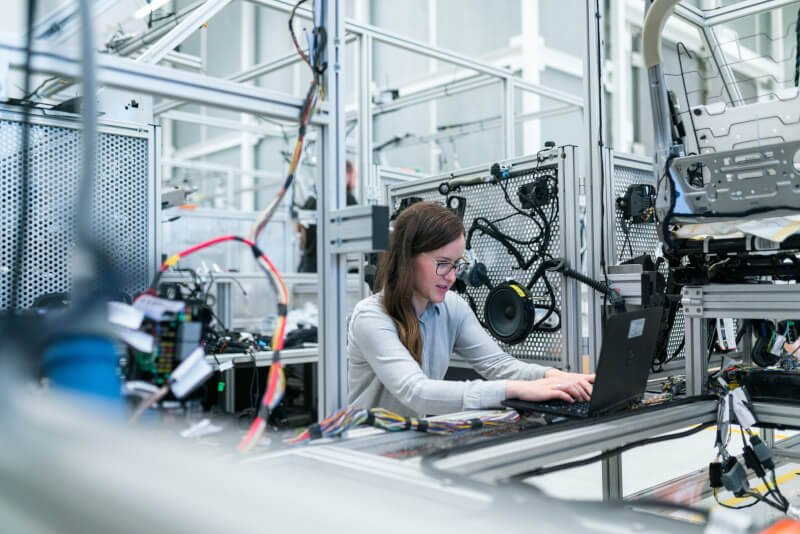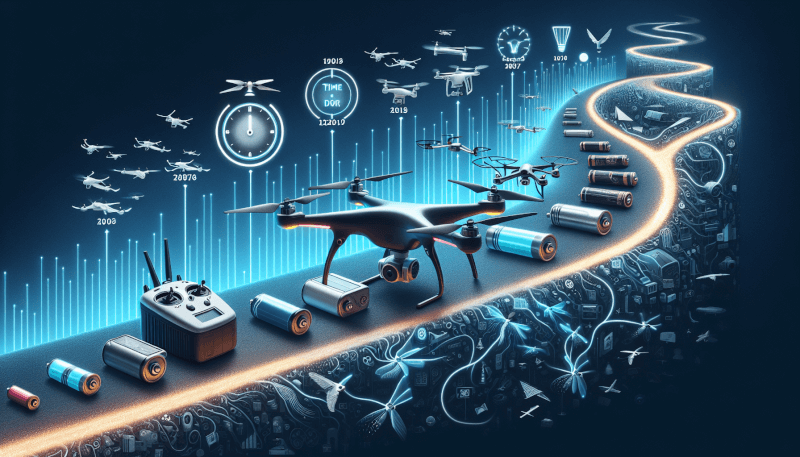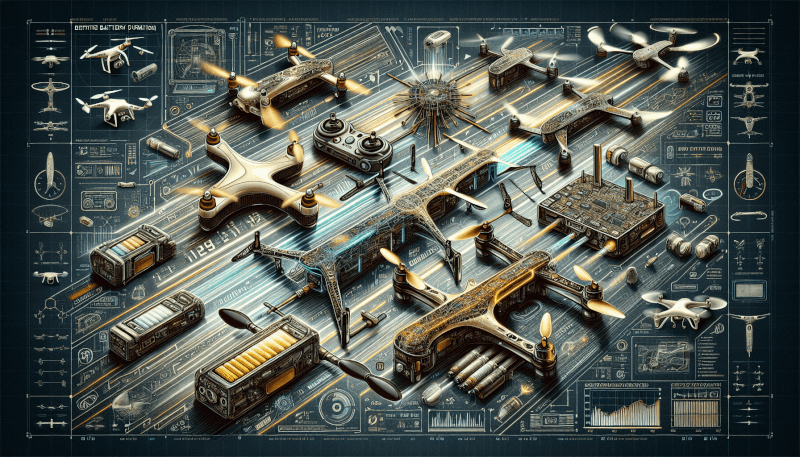Imagine experiencing the freedom of soaring through the skies, capturing breathtaking aerial footage, and exploring new perspectives. With advancements in drone technology, this dream is becoming a reality for more and more people. One of the key areas where significant progress has been made is in battery life. Longer flight times mean more time to explore, film, and discover. In this article, we will explore the exciting advancements in drone battery technology and how it is revolutionizing the possibilities of aerial photography and videography. Get ready to be amazed by the leaps and bounds that have been made in this crucial aspect of drone technology.

History of Drone Technology
Early developments
The history of drone technology dates back much further than most people might realize. You might be surprised to learn that the earliest recorded use of drones dates back to the mid-19th century. It was during this time that the Austrian army began experimenting with unmanned aerial balloons equipped with explosives, known as “aerial torpedoes,” for military purposes.
The concept of drones evolved significantly throughout the 20th century, with various countries exploring their potential in both military and civilian applications. In the 1960s, the United States developed and deployed the first practical modern drones, such as the Ryan Firebee series, for reconnaissance missions during the Vietnam War.
Emergence of commercial drones
While drones were initially primarily used for military purposes, the emergence of commercial drones has revolutionized a wide range of industries. Companies have recognized the potential of drones for tasks such as aerial photography, infrastructure inspection, agricultural monitoring, and even package deliveries.
The accessibility of commercial drones has increased exponentially in recent years, thanks to advancements in technology and regulation. With the increasing popularity of recreational drones, these aerial devices have become more affordable and user-friendly than ever before. However, one crucial aspect that still poses a challenge is the limitation of battery life.
Importance of Battery Life in Drones
Limitations of short battery life
One of the most significant limitations of drones’ current technology is their limited battery life. The amount of time a drone can stay airborne is directly proportional to the battery’s capacity and efficiency. For many drone enthusiasts and professional users alike, this limitation hinders the full potential of drone technology.
Short battery life affects various aspects of drone operations. Flight time directly impacts the range and coverage area of a drone, limiting its capabilities for tasks that require extended durations, such as surveying large areas or conducting long-distance inspections. Additionally, frequent battery changes or recharges can disrupt and delay operations, reducing overall efficiency.
Exploring longer flight durations
To overcome the limitations of short battery life, significant efforts have been made to increase flight durations. Battery technology advancements aim to achieve extended flight times without compromising the drones’ performance or payload capacity.

Current Battery Technologies
Lithium-ion batteries
Lithium-ion batteries are the most commonly used batteries in drones today. These rechargeable batteries have a high energy density, allowing drones to operate for longer periods compared to other battery technologies. Lithium-ion batteries are lightweight and offer a good balance between energy capacity, weight, and cost.
However, despite their advantages, lithium-ion batteries still have limitations in terms of flight time. The overall size and weight of drones restrict the battery size and capacity, making it challenging to achieve significantly longer flight durations with existing lithium-ion technology.
Lithium polymer batteries
Lithium polymer (LiPo) batteries are a variation of lithium-ion batteries, offering several advantages for drone applications. LiPo batteries are known for their higher energy density, allowing drones to fly for longer durations than traditional lithium-ion batteries.
LiPo batteries are also more flexible and can be shaped to fit different drone designs. This flexibility in battery shape enables manufacturers to optimize the available space within the drone’s frame and maximize the overall energy capacity.
Research and Development Efforts
Increasing energy density
Research and development efforts in the field of battery technology focus on increasing the energy density of batteries. By enhancing the energy storage capabilities of batteries, drones can stay airborne for longer periods without compromising performance or payload capacity.
Scientists and engineers are exploring various approaches to achieve higher energy density in batteries. These efforts include the development of new battery chemistries, such as solid-state batteries and graphene-based batteries, which hold the promise of significantly improving flight durations.
Improving battery management systems
Another critical aspect of improving drone battery life is optimizing battery management systems (BMS). BMS plays a crucial role in monitoring and controlling the battery’s discharge and charging cycles, ensuring optimal performance and maximizing battery life.
Advancements in battery management systems include the incorporation of intelligent software algorithms that can accurately estimate the remaining flight time and provide real-time feedback to the drone operator. Such systems help users plan their drone operations more efficiently and avoid unexpected power failures during critical missions.

New Materials and Technologies
Solid-state batteries
Solid-state batteries are one of the most promising advancements in battery technology. Unlike traditional lithium-ion batteries, which use liquid or gel electrolytes, solid-state batteries employ solid-state electrolytes. This eliminates the risk of leakage or thermal runaway, making these batteries safer and more stable.
Solid-state batteries offer the potential for increased energy density, longer battery life, and faster charging times. Moreover, their inherent safety benefits make them an ideal choice for drones, where reliability and safety are paramount.
Graphene-based batteries
Graphene, a two-dimensional carbon material, has gained significant attention in battery research due to its exceptional properties. Graphene-based batteries have the potential to revolutionize the drone industry by offering much higher energy densities and faster charging capabilities.
Graphene-based batteries can store more energy per unit weight compared to traditional lithium-ion batteries. Furthermore, graphene’s excellent electrical conductivity allows for faster charge and discharge rates, reducing the time it takes to recharge drone batteries.
Efficiency Enhancements
Propulsion system innovations
Battery life is not solely determined by the battery itself but also by the overall efficiency of the drone’s propulsion system. Innovations in propulsion systems aim to minimize energy wastage and maximize flight time.
Engineers are constantly exploring ways to optimize the design of drone motors and propellers. This involves reducing friction, improving aerodynamics, and utilizing lightweight materials. Efficient propulsion systems can significantly enhance battery life by minimizing power consumption during flight.
Lightweight materials
Reducing the weight of a drone can directly impact its battery life. By incorporating lightweight materials in the drone’s construction, manufacturers can minimize the energy required to keep the drone airborne.
Materials such as carbon fiber composites and lightweight alloys offer high strength and durability without adding excessive weight. As drone technology continues to evolve, the use of lightweight materials will become increasingly important in achieving longer flight durations.

Solar Power Integration
Solar panels on drone surfaces
One way to extend the battery life of drones is by integrating solar power systems. Solar panels can be installed on the surface of drones to capture sunlight and convert it into electrical energy. This approach allows drones to supplement their power needs while in flight, thus extending their overall flight time.
Solar power integration presents numerous advantages beyond extending battery life. It reduces the reliance on conventional charging methods, offers sustainability benefits, and enhances the autonomy of drones during long-duration missions.
Wireless charging via solar energy
Another solar power integration approach involves wireless charging systems. Ground-based charging stations equipped with solar panels can wirelessly transmit power to drones in mid-air. This eliminates the need for physical connections between drones and charging stations, enabling seamless and continuous charging during flight.
Wireless charging via solar energy has the potential to revolutionize the drone industry by providing an uninterrupted power supply, effectively unlimited flight time, and increased operational flexibility.
Swappable Battery Systems
Quick battery replacements
Swappable battery systems offer a practical solution to overcome the limitations of short battery life. Instead of waiting for a drone’s battery to recharge, operators can quickly replace depleted batteries with fully charged ones, minimizing downtime.
Swappable battery systems typically involve standard-sized battery packs that can be easily inserted and removed from drone frames. This allows for swift and hassle-free battery exchanges, enabling continuous operations without the need to wait for batteries to recharge.
Standardized battery packs
Standardizing drone battery packs can simplify battery management and offer compatibility across different drone models. This means that a single battery pack can be used interchangeably among multiple drones, streamlining operational logistics and minimizing the number of batteries required.
Standardized battery packs also enable more efficient charging and distribution systems, providing a cost-effective and environmentally-friendly solution for powering drones.

Regulatory Considerations
Battery capacity limitations
While advancements in battery technology offer promising improvements to drone battery life, regulatory agencies impose limitations on battery capacities to ensure safety and compliance. These limitations prevent the use of excessively large batteries that may pose a risk during flight, especially in populated areas.
Drone operators need to adhere to regulatory guidelines regarding battery capacity limitations to ensure safe and responsible drone operations.
Operational restriction assessment
Apart from battery capacity limitations, regulatory bodies may also impose operational restrictions on drone flights. These restrictions consider various factors such as flight altitude, distance from populated areas, and time limits to prevent potential risks or disruptions.
Drone operators must assess these operational restrictions and factor them into their battery planning. Adhering to these regulations ensures the safe and responsible use of drones, protecting both people and property.
Future Possibilities
Fully autonomous drones
The future of drone technology holds the promise of fully autonomous drones capable of performing tasks without human intervention. With advancements in artificial intelligence and machine learning, drones can become more autonomous in their decision-making and navigation capabilities.
Fully autonomous drones can optimize their flight paths, conserve battery energy more efficiently, and adapt their operations to changing environmental conditions. This increased autonomy has the potential to revolutionize industries such as delivery services, emergency response, and infrastructure inspection.
Perpetual flight capabilities
One of the ultimate goals in drone technology is achieving perpetual flight capabilities. With perpetual flight, drones would be able to stay airborne indefinitely without the need for manual intervention or battery replacements.
While perpetual flight capabilities are currently beyond the reach of existing technology, ongoing research and development efforts are continuously pushing the boundaries. Innovations in battery technology, solar power integration, and efficiency enhancements pave the way for a future where drones can fly for extended durations or even indefinitely, opening up endless possibilities for their applications.
In conclusion, battery life is a critical factor in enabling the full potential of drone technology. Advancements in battery technology, research and development efforts, new materials, efficiency enhancements, solar power integration, swappable battery systems, and regulatory considerations all contribute to extending the flight durations of drones. With the continuous progress being made in these areas, the future of drones holds exciting possibilities, including fully autonomous drones and perpetual flight capabilities. As the drone industry continues to evolve, battery technology will play a pivotal role in unlocking new frontiers and transforming a wide range of industries.


